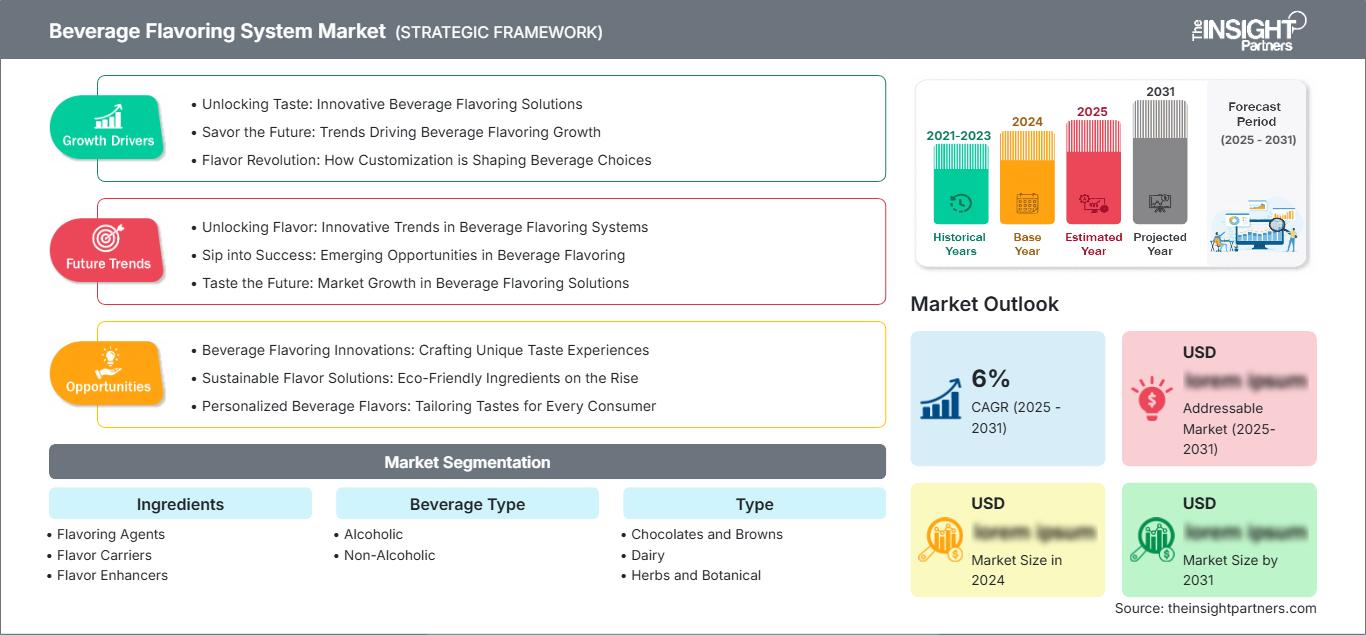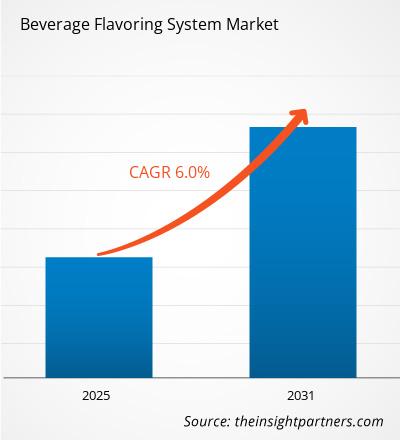The Beverage Flavoring Systems Market size is expected to reach US$ 8.05 Billion by 2031. The market is anticipated to register a CAGR of 5.9% during 2025-2031.
The report is categorized by Ingredients (Flavoring Agents, Flavor Carriers, Flavor Enhancers) and further analyzes the market based on Beverage Type (Alcoholic, Non-Alcoholic). It also examines the market by Type (Chocolates and Browns, Dairy, Herbs and Botanical, Fruits and Vegetables) and Industry Origin (Natural, Artificial, Nature-Identical). A comprehensive breakdown is provided at global, regional, and country levels for each of these key segments.
The report includes market size and forecasts across all segments, presenting values in USD. It also delivers key statistics on the current market status of leading players, along with insights into prevailing market trends and emerging opportunities.
Purpose of the Report
The report Beverage Flavoring System Market by The Insight Partners aims to describe the present landscape and future growth, top driving factors, challenges, and opportunities. This will provide insights to various business stakeholders, such as:
- Technology Providers/Manufacturers: To understand the evolving market dynamics and know the potential growth opportunities, enabling them to make informed strategic decisions.
- Investors: To conduct a comprehensive trend analysis regarding the market growth rate, market financial projections, and opportunities that exist across the value chain.
- Regulatory bodies: To regulate policies and police activities in the market with the aim of minimizing abuse, preserving investor trust and confidence, and upholding the integrity and stability of the market.
Beverage Flavoring System Market Segmentation Ingredients
- Flavoring Agents
- Flavor Carriers
- Flavor Enhancers
Beverage Type
- Alcoholic
- Non-Alcoholic
Type
- Chocolates and Browns
- Dairy
- Herbs and Botanical
- Fruits and Vegetables
Origin
- Natural
- Artificial
- Nature-Identical
You will get customization on any report - free of charge - including parts of this report, or country-level analysis, Excel Data pack, as well as avail great offers and discounts for start-ups & universities
Beverage Flavoring System Market: Strategic Insights

-
Get Top Key Market Trends of this report.This FREE sample will include data analysis, ranging from market trends to estimates and forecasts.
Beverage Flavoring System Market Growth Drivers
- Unlocking Taste: Innovative Beverage Flavoring Solutions
- Savor the Future: Trends Driving Beverage Flavoring Growth
- Flavor Revolution: How Customization is Shaping Beverage Choices
Beverage Flavoring System Market Future Trends
- Unlocking Flavor: Innovative Trends in Beverage Flavoring Systems
- Sip into Success: Emerging Opportunities in Beverage Flavoring
- Taste the Future: Market Growth in Beverage Flavoring Solutions
Beverage Flavoring System Market Opportunities
- Beverage Flavoring Innovations: Crafting Unique Taste Experiences
- Sustainable Flavor Solutions: Eco-Friendly Ingredients on the Rise
- Personalized Beverage Flavors: Tailoring Tastes for Every Consumer
The regional trends and factors influencing the Beverage Flavoring System Market throughout the forecast period have been thoroughly explained by the analysts at The Insight Partners. This section also discusses Beverage Flavoring System Market segments and geography across North America, Europe, Asia Pacific, Middle East and Africa, and South and Central America.
Beverage Flavoring System Market Report Scope
| Report Attribute | Details |
|---|---|
| Market size in 2024 | US$ XX Billion |
| Market Size by 2031 | US$ 8.05 Billion |
| Global CAGR (2025 - 2031) | 5.9% |
| Historical Data | 2021-2023 |
| Forecast period | 2025-2031 |
| Segments Covered |
By Ingredients
|
| Regions and Countries Covered |
North America
|
| Market leaders and key company profiles |
|
Beverage Flavoring System Market Players Density: Understanding Its Impact on Business Dynamics
The Beverage Flavoring System Market is growing rapidly, driven by increasing end-user demand due to factors such as evolving consumer preferences, technological advancements, and greater awareness of the product's benefits. As demand rises, businesses are expanding their offerings, innovating to meet consumer needs, and capitalizing on emerging trends, which further fuels market growth.

- Get the Beverage Flavoring System Market top key players overview
Key Selling Points
- Comprehensive Coverage: The report comprehensively covers the analysis of products, services, types, and end users of the Beverage Flavoring System Market, providing a holistic landscape.
- Expert Analysis: The report is compiled based on the in-depth understanding of industry experts and analysts.
- Up-to-date Information: The report assures business relevance due to its coverage of recent information and data trends.
- Customization Options: This report can be customized to cater to specific client requirements and suit the business strategies aptly.
The research report on the Beverage Flavoring System Market can, therefore, help spearhead the trail of decoding and understanding the industry scenario and growth prospects. Although there can be a few valid concerns, the overall benefits of this report tend to outweigh the disadvantages.
Frequently Asked Questions
What is the expected CAGR of the beverage flavoring system market?
What are the options available for the customization of this report?
Which are the leading players operating in the beverage flavoring system market?
What are the deliverable formats of the beverage flavoring system market report?
What are the future trends of the beverage flavoring system market?
What are the driving factors impacting the global beverage flavoring system market?
- Historical Analysis (2 Years), Base Year, Forecast (7 Years) with CAGR
- PEST and SWOT Analysis
- Market Size Value / Volume - Global, Regional, Country
- Industry and Competitive Landscape
- Excel Dataset
Recent Reports
Testimonials
Reason to Buy
- Informed Decision-Making
- Understanding Market Dynamics
- Competitive Analysis
- Identifying Emerging Markets
- Customer Insights
- Market Forecasts
- Risk Mitigation
- Boosting Operational Efficiency
- Strategic Planning
- Investment Justification
- Tracking Industry Innovations
- Aligning with Regulatory Trends





















 Get Free Sample For
Get Free Sample For